IV.1.2.7.Workers
availability
The results in table 13 indicate that 93.8 % do not hire any
permanent workers and 6.2 % of interviewed people hire 1 to 2 permanent
workers. However percentage of farmers hiring casual workers within wealth
groups varies from one group to another. While 22.2% of well-off farmers can
afford employing 1 to 2 permanent workers, only 9.1% of
intermediate farmers can do it and no single poor family can
recruit any permanent worker due to low income. In addition 70.8% of all
surveyed farmers do not hire temporally workers but 100% of well off farmer
hire between 1 to 2 workers or more.
Comparing the results of the table 13, it is clear that well
off farmers prefer recruiting more temporarily workers than permanent workers
due to the fact that the former are cheaper and are hired for only specific
tasks (sowing, first and, second tillage) that require extra physical energy.
Table 13: Permanent and
temporarily Labour hired in relation to farmer wealth status
|
Hired permanent and temporary
workers
Wealth categories
|
No labour hired
|
1 to 2 workers or more
|
Total
|
|
|
|
Well-off farmer
|
7
|
2
|
9
|
|
77,8%
|
22,2%
|
100%
|
|
Intermediate farmer
|
20
|
2
|
22
|
|
90,9%
|
9,10%
|
100%
|
|
Poor farmer
|
34
|
0
|
34
|
|
100%
|
0,0%
|
100%
|
|
Total
|
61
|
4
|
65
|
|
93,8%
|
6,2%
|
100,0%
|
|
temporary workers
|
|
|
|
|
Well-off farmer
|
0
|
9
|
9
|
|
0,0%
|
100,0%
|
100,0%
|
|
Intermediate farmer
|
15
|
7
|
22
|
|
68,20%
|
31,8%
|
100,0%
|
|
Poor farmer
|
31
|
3
|
34
|
|
91,20%
|
8,80%
|
100,0%
|
|
Total
|
46
|
19
|
65
|
|
70,8%
|
29,20%
|
100,0%
|
IV.1.2.8.Labour sale
Table 14: Labour sale
distribution in wealth groups categories
|
Labour sale
Wealth category
|
|
|
|
Total
|
|
Yes
|
No
|
Occasionally
|
|
Well-off farmer
|
0
|
9
|
0
|
9
|
|
|
,0%
|
100,0%
|
,0%
|
100,0%
|
|
Intermediate farmer
|
4
|
16
|
2
|
22
|
|
|
18,2%
|
72,7%
|
9,1%
|
100,0%
|
|
Poor farmer
|
13
|
18
|
3
|
34
|
|
|
38,2%
|
52,9%
|
8,8%
|
100,0%
|
|
Total
|
17
|
43
|
5
|
65
|
|
26,2%
|
66,2%
|
7,7%
|
100,0%
|
The results shown in the table below indicate that few farmers
(26%) sell labour and most of them preferring working permanently on their
farms. As selling labour is one of the income generating activity, a good
number of poor farmers (46 %) do sell labour. We expected this number to be
larger, but it is not the case probably due to the fact that the group is
mostly composed of old widowers and other vulnerable persons.
IV.1.2.9.Important food
crops
The general observation of data presented below indicates that
80% of the surveyed population ranked beans and sweet potatoes as their most
important food crop, these are traditional food crops that contribute to food
security of rural families in Rwanda, followed by bean alone (9.2%) at the
second position. Sweet potatoes, rice, and Irish potato are not favored as
food crop by the wealthy group; however, they can be cultivated for market
destination.
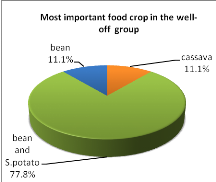
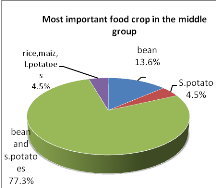
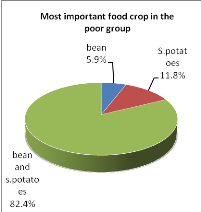
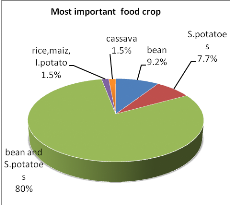
Figure 3: Most important food
crop
IV.1.2.10.Important cash
crops
In general, the majority of the surveyed farmers in Shanga
cell (46.2%) declared coffee as their most important income-earning crop
followed by vegetables (24.6%). In total 88.9% of wealthy farmers, 63.6% of the
intermediate and 23.5% of the poor farmers interviewed grow coffee and get
money out of it.
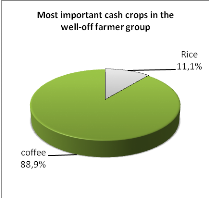
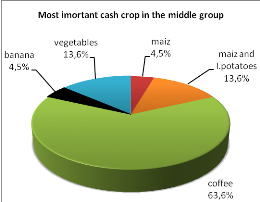
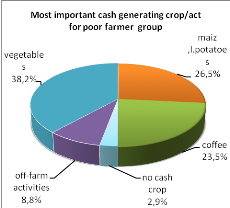
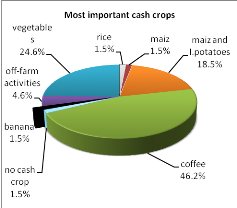
Figure 4: Most important
income-earning crop/Act
It is interesting to notice that poor farmers prefer diversify
cash crops on farmer because of constraint of land shortage and the desire of
attaining food self sufficiency.
| 


